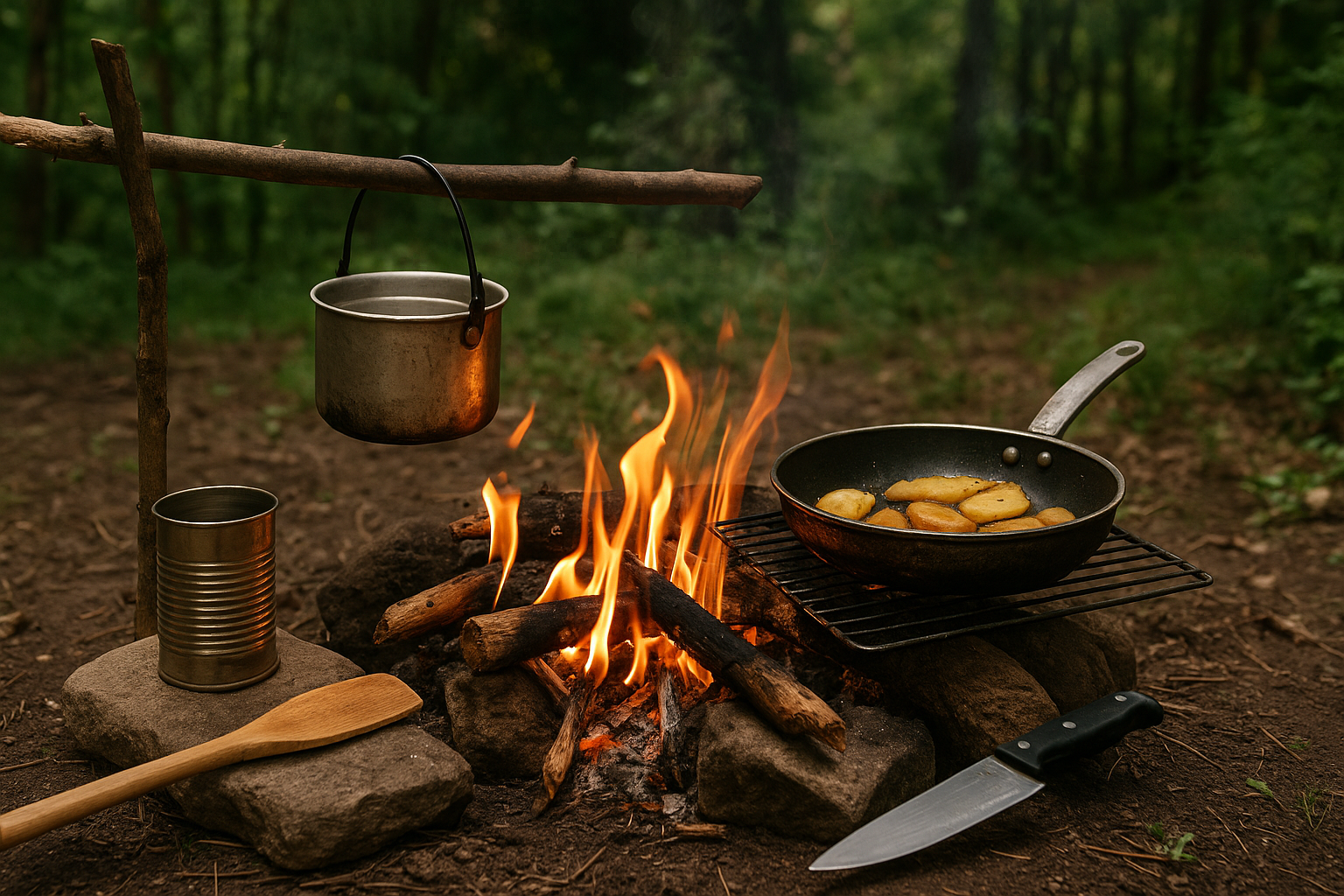You arrive at camp, ready to cook. You open your bag—only to realize your camp kitchen kit is missing. No pots, no utensils, not even a stove. Panic sets in, but don’t worry.
Resourcefulness is the survivalist’s secret weapon. You can still enjoy hot meals, brew coffee, and keep your camp kitchen running—without spending a dime or heading back to the store.
This guide will show you ingenious ways to improvise cooking gear from what’s already around you—your campsite, your pack, and even natural materials.
🔥 1️⃣ DIY Cooking Surfaces and Containers
✅ Flat Rocks as Griddles
- Find a flat, clean rock (granite, slate) near your campsite.
- Clean it thoroughly and place it over embers or coals.
- Use it to cook flatbreads, bacon, or veggies.
✅ Aluminum Foil Hacks
- Have foil from snacks or supplies? Fold it into a makeshift pan or plate.
- Create a pocket to cook food over coals.
✅ Tin Cans as Pots
- Empty cans from canned food can serve as cooking vessels.
- Remove labels and wash thoroughly.
- Use them to boil water, cook soups, or make hot drinks.
✅ Green Sticks as Skewers
- Cut fresh greenwood branches (willow, alder) and sharpen them.
- Use them as skewers for roasting or as pot supports over a fire.
🏕️ 2️⃣ Fuel-Free Cooking Techniques
✅ Rock Boiling
- Heat rocks in your campfire until they’re red-hot.
- Drop them into a water container (e.g., metal bottle, tin can) to bring water to a boil.
✅ Solar Cooking
- Use a reflective emergency blanket or aluminum foil to create a solar oven.
- Position a black pot or container inside the reflective area to absorb sunlight and heat food.
✅ Cold Soaking
- Rehydrate instant oats, couscous, or ramen by soaking them in water for several hours.
- No heat required—just patience and a sealed container.
🍲 3️⃣ Improvise Utensils from Nature and Gear
✅ Stick Spatula or Spoon
- Carve a flat stick into a makeshift spatula or spoon.
- Sand smooth with a rock or knife edge.
✅ Knife as a Multi-Tool
- Use your pocketknife or multitool as a cutting board, can opener, and stirrer.
- Keep it clean and handle with care.
✅ Plastic Bottles for Mixing and Storage
- Clean water bottles or food containers can double as mixing bowls or storage.
✅ Emergency Pot Lids
- Use a flat rock, a plate, or even a large leaf (banana, sycamore) as a lid to retain heat.
🧼 4️⃣ Makeshift Cleaning Gear
✅ Sand or Ash as a Scrubber
- Use clean sand or wood ash to scrub pots and utensils.
- Acts as a mild abrasive to remove stuck food.
✅ Green Branch Brushes
- Bundle fresh pine or fir branches to create a natural scrub brush.
✅ Dry Wipe Method
- Wipe pots clean with leaves, grass, or a cloth before washing with water.
✅ Minimal Soap, Maximum Rinse
- If you have soap, use it sparingly and rinse thoroughly.
- Avoid contaminating natural water sources—pack out wastewater if needed.
🏞️ 5️⃣ Natural Fuel Sources When You Have No Stove
✅ Twig and Stick Fires
- Gather dry twigs, pinecones, and small branches.
- Use a wind-protected area and build a small fire for cooking.
✅ Charcoal from Previous Campfires
- If you find leftover charcoal in an old fire ring, use it to fuel your own fire.
✅ Improvised Reflector Ovens
- Dig a shallow pit, line it with stones, and cover it with foil or metal to reflect heat onto food.
🧠 6️⃣ Pro Tips for Improvised Cooking
✅ Always Check for Fire Restrictions
- Before starting any fire or using natural fuel sources, confirm there are no fire bans.
- Be mindful of wind and local conditions.
✅ Use What You Have in Your Pack
- Emergency blankets double as reflectors.
- Water bottles and canisters become makeshift pots.
- Shoelaces or paracord can secure improvised tripod cooking setups.
✅ Plan Meals That Require Minimal Gear
- One-pot meals, cold-soak options, and simple stews reduce the need for multiple utensils.
- Pack high-calorie snacks and pre-cooked foods if you anticipate losing gear.
🍽️ 7️⃣ Sample Meal Plan Without Gear
🥣 Breakfast:
- Cold-soaked overnight oats in a water bottle.
- Trail mix or energy bars.
🍲 Lunch:
- Canned tuna or salmon eaten with a carved stick fork.
- Crackers or flatbread warmed on a rock.
🍛 Dinner:
- Soup or stew made by boiling water in a tin can with hot rocks.
- Roasted veggies or skewered meat over a stick fire.
🍫 Dessert:
- Melted chocolate on flatbread warmed over a rock.
- Fresh berries (if available).
🏕️ 8️⃣ Camp Kitchen Discipline = No-Gear Resilience
✅ Always Keep a “Micro-Kitchen” on You
- A knife, a small waterproof container, and emergency fire-starting tools.
- Lightweight but lifesaving if you lose your main gear.
✅ Pack Multi-Use Items
- Foil, paracord, an emergency blanket, and a collapsible cup can fill multiple roles.
✅ Stay Organized
- Keep critical items in a dedicated bag or pouch.
- Label bags and pouches for quick identification.
🌄 Conclusion: You Don’t Need Fancy Gear to Survive
Losing your camping kitchen kit is frustrating—but it’s far from a disaster. With a little creativity and resourcefulness, you can improvise everything from stoves to utensils to pots using natural materials and gear already in your pack.
🔥 Use natural supports and heat sources.
🔥 Transform found items into cooking tools.
🔥 Stay adaptable, and you’ll never go hungry.
Because survival isn’t about the gear you own—it’s about the skills you carry.
👉 Bookmark this guide for your next trip—and be ready to cook, even if your kit doesn’t make it.

